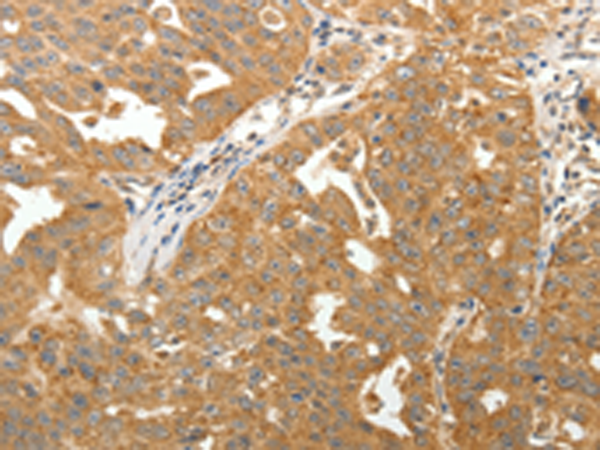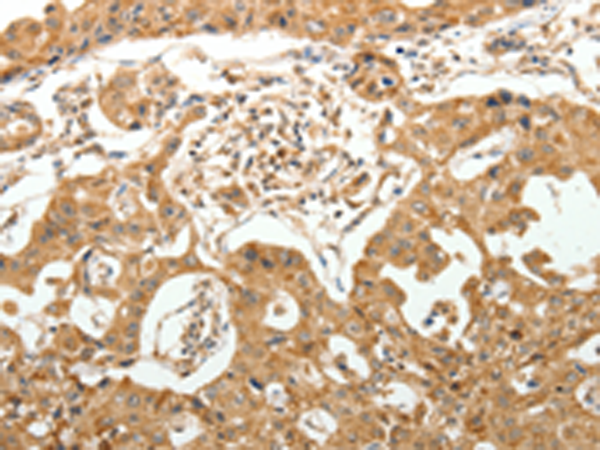

| WB | 咨询技术 | Human,Mouse,Rat |
| IF | 咨询技术 | Human,Mouse,Rat |
| IHC | 1/50-1/200 | Human,Mouse,Rat |
| ICC | 技术咨询 | Human,Mouse,Rat |
| FCM | 咨询技术 | Human,Mouse,Rat |
| Elisa | 1/3000-1/10000 | Human,Mouse,Rat |
| Aliases | MAP5; FUTSCH |
| Host/Isotype | Rabbit IgG |
| Antibody Type | Primary antibody |
| Storage | Store at 4°C short term. Aliquot and store at -20°C long term. Avoid freeze/thaw cycles. |
| Species Reactivity | Human, Mouse, Rat |
| Immunogen | Synthetic peptide of human MAP1B |
| Formulation | Purified antibody in PBS with 0.05% sodium azide and 50% glycerol. |
+ +
以下是关于MAP1B抗体的3篇参考文献及简要摘要:
---
1. **文献名称**: "Microtubule-associated protein 1B (MAP1B) is required for dendritic spine development in hippocampal neurons"
**作者**: Tortosa E. et al.
**摘要**: 该研究利用MAP1B特异性抗体结合免疫荧光技术,证明MAP1B通过调节微管稳定性影响海马神经元树突棘的形态发生,并揭示其在突触可塑性中的潜在作用。
2. **文献名称**: "MAP1B phosphorylation is critical for axonal regeneration in mature neurons"
**作者**: Barnat M. et al.
**摘要**: 文章通过Western blot和免疫组化分析,使用MAP1B抗体发现其磷酸化状态调控成熟神经元轴突再生能力,为神经损伤修复研究提供了新靶点。
3. **文献名称**: "Characterization of a monoclonal antibody to microtubule-associated protein 1B (MAP1B): Distinct phosphorylation states in developing brain"
**作者**: Sato-Yoshitake R. et al.
**摘要**: 该文献描述了一种特异性识别MAP1B的单克隆抗体的开发,并验证其在发育中大脑不同区域检测MAP1B磷酸化动态变化的有效性,揭示了其在神经发育中的时空表达模式。
---
以上文献均聚焦于MAP1B抗体的应用及其在神经元结构与功能研究中的关键作用。
The microtubule-associated protein 1B (MAP1B) is a cytoskeletal protein critical for neuronal development and synaptic plasticity. It belongs to the MAP family, which stabilizes microtubules and regulates their dynamics. MAP1B is highly expressed during early brain development, playing key roles in axonal elongation, growth cone guidance, and dendritic arborization. Its activity is modulated by phosphorylation, which influences microtubule stability and interactions with other cytoskeletal components. In mature neurons, MAP1B remains involved in maintaining structural integrity and modulating synaptic function.
MAP1B antibodies are essential tools for studying its expression, localization, and post-translational modifications. They are widely used in techniques like Western blotting, immunohistochemistry, and immunofluorescence to investigate MAP1B's roles in neurodevelopment, neurodegeneration (e.g., Alzheimer’s disease), and axonal regeneration. Some antibodies specifically target phosphorylated isoforms, enabling research into signaling pathways regulating MAP1B activity. Dysregulation of MAP1B has been linked to neurological disorders, making these antibodies valuable for both basic research and clinical diagnostics.
×